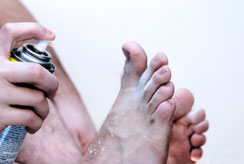









 Athlete's foot is a fungal infection that causes cracked red patches to form on the feet, usually between the toes, which can lead to itching, burning and other troubling symptoms. These infections may spread to the toenails as well, a condition known as onychomycosis, causing them to change color, thicken, or crumble.
Athlete's foot is a fungal infection that causes cracked red patches to form on the feet, usually between the toes, which can lead to itching, burning and other troubling symptoms. These infections may spread to the toenails as well, a condition known as onychomycosis, causing them to change color, thicken, or crumble.
The fungi that cause athlete’s foot, a group called dermatophytes, grow fastest in warm, moist conditions. Accordingly, risk factors for contracting fungal infections include keeping the feet wet for long periods of time, walking barefoot in wet public places such as pools or showers, wearing closed shoes that do not allow the feet to breathe, and having sweaty feet. Skin-to-skin contact with an infected person can also spread the infection.
Patients with athlete's foot may experience:
Fungal infections may be mild or severe, last a short or a long time, clear on their own or require professional treatment. They may recur over time. They may also develop into more significant problems such as bacterial infections, especially if a person scratches at the infected areas. Fortunately, there are several treatment options available to treat the infection and prevent it from recurring.
Patients whose condition has not responded to over-the-counter medications may require prescription-strength topical or oral medications, while your doctor may also recommend wet dressings, steroid ointments or cold compresses to treat blisters or other skin symptoms.
Plantar warts are non-cancerous growths that develop on the soles of the feet as a result of the human papillomavirus (HPV). HPV enters the body through tiny breaks in the skin, which are often present beneath pressure points in the feet on the heels or balls. Many patients develop warts after walking barefoot in a public place, as the HPV virus tends to thrive in warm, moist environments. These warts appear on the skin as a small, hard bump that may be gray or brown with well-defined boundaries. In some patients, they may cause pain or tenderness when walking.
While plantar warts are not usually a serious condition, many patients experience pain or embarrassment regarding this condition. It is important for patients to seek medical attention if their wart changes color or appearance, grows in size or if the patient has diabetes or a circulatory disorder, as they are prone to infection and should not attempt home care.
Plantar warts can be removed through several different noninvasive procedures, including cryotherapy (freezing), laser surgery, cantharidin, immunotherapy and medication injections. Dr. Dixon will decide which treatment option is best for you based on your individual condition. Some plantar warts may not require any treatment at all. Patients can reduce their risk of plantar warts by keeping the feet clean and dry, avoiding walking barefoot in public places and not sharing nail files or clippers with others.